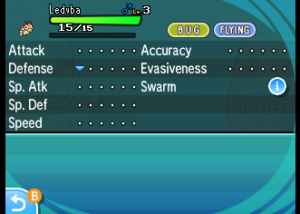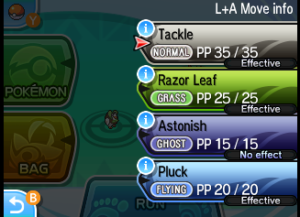Pokemon Moon – Nintendo 3DS
 Platform: Nintendo 3DS
Platform: Nintendo 3DS
Release Date (NA): November 18th, 2016
Developer: Game Freak
Publisher: Nintendo
Genre: Role-Playing
Nerd Rating: 6.5 out of 10
After what hasn’t really been that long of a wait, the newest, seventh generation of Pokemon games have arrived in the form of Pokemon Sun and Pokemon Moon. Although like most paired Pokemon releases, the majority of the gameplay mechanics in these two are the same, for this review I’ll be focusing more on Pokemon Moon.

Events in Pokemon Moon typically take place at night, with the in-game day-night system pushed twelve hours ahead.
Coming out barely two years after the release of the generation three remakes, Pokemon Omega Ruby and Alpha Sapphire, it was quite fair to say that the announcement that Nintendo was already moving onto the next generation left me rather shocked. Not specifically because of the two-year gap, as the time between core series Pokemon games is usually 1-2 years, but because the core sixth generation titles wouldn’t be receiving any sort of sequel or third edition. When you think about it though, it’s crazy how much franchises like Assassin’s Creed are picked on for yearly installments, when the last few Pokemon releases have been getting closer and closer together.
What isn’t so crazy however, is how that may have actually been a significant factor in the delivery of Pokemon Sun and Moon. Regardless of how much of a fan you may be of the Pokemon series, the honest truth is that although the series has received numerous graphical, mechanical, and other improvements, the core gameplay has remained the same for the last twenty years. Although the methods may differ from game to game, each installment is, at heart, the same story about a ten year old child who gets their first Pokemon, goes on an adventure throughout their chosen region, collecting eight badges, defeating criminal organizations, and beating the reigning Elite Four and Champion, all while filling up the grand ‘ol Pokedex.

After completing each island’s Captains, the player takes on the Kahuna to complete the island’s Grand Trial. Similar to the Elite Four in previous Pokemon games…but not this generation’s replacement for it.
For a lot of older fans, the fact that the core gameplay has remained almost stagnant for the last two decades is a real turn-off for them. They’re tired of the same tried (but true) gameplay, just with about one hundred new Pokemon each installment, they want something refreshing, they want something new. And that is where Pokemon Moon begins.
The story of Pokemon Moon begins in the Hau’oli Outskirts of Melemele Island at night where our player has just moved to with their mother from the Kanto region. The player’s cousin, Kukui, just happens to be the region’s Pokemon Professor, taking them under his wing to start their Pokemon journey by getting their first Pokemon from the island’s Kahuna at a nearby village. While heading to the island’s ancient ruins to find the Kahuna, the player runs into a mysterious girl named Lillie and her equally mysterious Pokemon Cosmog, who is beset by Spearow on the old bridge leading to the ruins.
The player tries to save Cosmog, but it blows part of the bridge up trying to protect the player and the island’s guardian Pokemon, Tapu Koko, charges in from the sky to save them both. Although Tapu Koko disappears, it leaves the player a special stone, and the player and Lillie return to the village to find the Kahuna already waiting for them. Right after, the player chooses, and is chosen by their starter Pokemon, receives their first Pokedex, meets their rival Hau, finds out that Lillie is the Professor’s assistant, and is told they should embark on the island challenge by Professor Kukui.

One of the coolest, but mostly glossed over features new to Pokemon Moon is the Battle Royal, a four-way Pokemon battle facility you can take part in half-way through the game.
While it may not seem like it, the game’s intro is ridiculously longer than the norm for Pokemon games, lasting at the least, an hour in length in which several “days” pass before the player can even truly “start” their journey. And even then, there’s at least another hour of random cutscenes, trainer battles, the introduction to this generation’s purposefully terrible criminal team, and other challenges before the player can really begin their so-called “island challenge.”
The fore-mentioned “Island Challenge” is this generation’s version of the Pokemon League, but rather different. Basically, each of the four islands of Alola have one trainer called a “Kahuna” who is the “strongest trainer on the island” and several “Captains” who hold trials that must be completed before the player can challenge the Kahuna to complete that island’s Grand Trial. The trials that the Captains of each island hold are, on the surface, unique and different, but in reality all boil down to a “fight three regular Pokemon then fight one special Pokemon” which is incredibly disappointing.

Following in Pokemon X and Y‘s vein, Pokemon Moon also gives players the chance to customize their character with different clothes, hairstyles, hair colors, and more eye colors.
This special Pokemon at the end of each trial is referred to as a “Totem Pokemon,” and really all they are are evolved Pokemon with a special buff and the ability to call down other Pokemon to assist them. After completing a trial the player obtains an item called a Z-crystal, a hold item that allows said Pokemon to use a special version of a move (usually by type). The three starters Pokemon, including some other Pokemon like Eevee, Pikachu, and Snorlax, also have special Z-crystals that only they can hold to use a special version of their signature moves. However, the Z-crystals are a pretty lame replacement for badges and Mega Stones.
And while the whole Island Challenge seems very simple, unlike just going to a city’s gym in the other Pokemon games, fighting each island’s Kahunas and completing the Captain’s trials feel like lesser events to the, at times, ridiculously predictable plot. When random characters weren’t demanding battles in the middle of important plot events, there was a cutscene every few steps leading me down a straightforward route to make sure I was going the right way. The game also made it a point to build up Lillie’s character substantially through even more cutscenes, which could have definitely been trimmed down at times. I was actually more disappointed that more time during the main story wasn’t devoted to the explanation of Ultra Wormholes and Ultra Beasts, as not only did they play a huge role in the game’s climax, but five of them didn’t even make an appearance until the short post-story.

With the in-game QR Scanner, players can share QR codes for Pokemon they’ve caught for “Seen” entries. Try scanning this image in Pokemon Moon (or Sun) to unlock a seen entry for Rowlet in your Pokedex!
Although I’ve rambled on about the bad for quite a while, Pokemon Moon isn’t entirely a terrible game. Quite a number of new UI changes have been implemented to make battling much smoother including; an information screen dedicated to showing any stat changes during a match, type effectiveness descriptors next to your Pokemon’s moves, a Pokeball hotkey, and pop-up summaries of each Pokemon’s move on the Attack screen. Pokemon Moon is also much more graphically intense compared to its predecessors, with fully fleshed out cutscenes, Pokemon trainers who actively move in the background of battles, and environments and characters equatable to the GameCube Pokemon Colosseum games.
Pokemon Moon also has some interesting differences between it and Pokemon Sun, in a similar vein to the fifth generation’s Pokemon Black and White’s. In Pokemon Moon, the in-game clock is set twelve hours ahead, so what would’ve been considered daytime in other Pokemon games now takes place at night, and vice-versa. Important in-game events, such as the long introduction and ending scenes, are also fixed to take place at night. Some of this version’s Totem Pokemon are also different, for example, the first trial which uses the new Alolan Ratticate instead of Gumshoos.
[ezcol_1half] [/ezcol_1half] [ezcol_1half_end]
[/ezcol_1half] [ezcol_1half_end] [/ezcol_1half_end]
[/ezcol_1half_end]
These, although still small differences, can make an impact on team-building later on in the game. The game’s biggest fault, however, is the lack of real challenge. Sure, you’ve got the obvious stuff; powerful Pokemon like Bagon available early in-game, supporting characters who heal your Pokemon and stock you with medicine and Pokeballs every cutscene, the many random trainer encounters with a single Pokemon to fight with, etc. This isn’t something that started with the seventh generation, but something that one would have thought would be fixed by Pokemon Sun and Moon‘s re-thinking of the core Pokemon mechanics.

Forget about having a designated HM Slave, HMs have been replaced by Ride Pokemon that can be called to handle environmental issues (although I really liked Waterfall as a move)!
All in all though, for Pokemon Moon, the folks at Game Freak sat down and really combed over the idea of what a Pokemon game is and could be. They, of course, thought of those graphical, mechanical, and other improvements that are expected every new installment, but then they thought, how can we make this different? As they thought about it, they took conventions that long-time series fans knew and either removed or flipped them on their heads. What came out of that is a Pokemon game that, while not the greatest the series has wrought, is probably the most original and most refreshing, and will hopefully give longtime Pokemon Masters a reason to trade their smartphones back in for Nintendo 3DS’s.
On a final note, players cannot yet transfer Pokemon from Pokemon Bank and their Virtual Console Pokemon games to Pokemon Moon, yet. Last I heard there was an update coming in January that will mend that. When it happens, however, make sure you’ve also downloaded PokeTransport from the Pokemon Bank menu, as it will be used to transport your boxed Pokemon in Red/Blue/Yellow/Green into Pokemon Bank, and then Pokemon Moon!
Share This Post
One Comment








Recent Comments